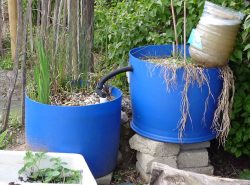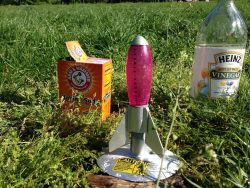Outdoor Math and Science Projects to Do with Middle School Students
As the days grow longer and temperatures rise, it’s a great time to take STEM education outdoors. We’ve put together a collection of innovative activities that combine the fun of outdoor play with key math and science skills. These projects not only enhance students’ understanding of essential concepts but also encourage exploration and critical thinking, all while staying aligned with middle school curriculum standards.
Educators in need of educational resource support to facilitate outdoor math and science activities can join the Educator Lending Library to borrow hands-on, project-based learning materials.
Outdoor Water Filtration Challenge
The Outdoor Water Filtration Challenge offers an engaging opportunity for middle school students to apply environmental science and engineering principles in a hands-on, real-world project. In this activity, students design and build their own water filtration systems using natural materials like sand, gravel, and charcoal to clean dirty water. This project introduces key science concepts such as the water cycle and filtration processes, while also encouraging students to think critically about how these systems work in the real world. As students test their filtration systems, they measure the effectiveness of different materials and designs, refining their models based on trial and error. On the math side, students calculate the volume of water they are filtering and measure the amount of clean water produced, honing their skills in measurement and volume calculations.
To get started, teachers can provide simple materials such as plastic bottles, coffee filters, and various types of sand or soil, along with a supply of contaminated water (such as muddy or colored water) to test the filtration systems. This project not only reinforces scientific and mathematical principles but also challenges students to think critically about environmental issues and the importance of clean water in our daily lives.
Science Focus: Water cycle, filtration.
Math Focus: Measurements, volume calculations.
Career Connection: Renewable energy engineer, water treatment plant technician.

Windmill Design & Build
The windmill design and build project offers a fan-tastic opportunity for middle school students to explore the principles of wind energy, aerodynamics, and engineering in a hands-on way. In this activity, students are challenged to design and construct their own windmills, testing different blade shapes and angles to see how they affect the efficiency and power output of their creations. This project provides a real-world connection to the growing field of renewable energy, helping students understand how wind energy is harnessed for practical use. As they experiment, students delve into science concepts, while also applying essential math skills, including calculating angles, proportions, and measurements to optimize their designs.
To get started, teachers can provide basic materials like cardboard, straws, and tape, along with a small motor or generator to measure the windmill’s power output. This hands-on project not only reinforces key scientific principles but also encourages critical thinking, creativity, and problem-solving as students work to design the most efficient windmill possible.
Science Focus: Wind energy, aerodynamics.
Math Focus: Angles, proportions, measurements.
Career Connection: Renewable energy engineer, wind turbine technician.
Rocket Launch with Baking Soda & Vinegar
Launching rockets with baking soda and vinegar is an engaging and dynamic activity that brings together chemistry, physics, and math in a reaction-packed hands-on experiment. In this project, middle school students can explore chemical reactions by mixing baking soda and vinegar to create an explosion of gas that propels a homemade rocket into the air. By varying the amounts of baking soda and vinegar, students can experiment with how these changes affect the rocket’s flight, analyzing the role of air pressure in creating the force necessary for launch. This activity introduces students to essential science concepts like chemical reactions and air pressure, while also incorporating physics concepts related to force and motion. On the math side, students can measure the rocket’s height, distance, and flight time, collecting data to calculate the rocket’s trajectory and speed.
To get started, teachers can provide simple materials like plastic bottles, baking soda, vinegar, and measuring tools, allowing students to design and adjust their rockets for optimal performance. This project not only sparks curiosity but also helps students apply scientific and mathematical principles in an interactive, real-world context.
Science Focus: Chemical reactions, air pressure.
Math Focus: Measurement of height, time, distance.
Career Connection: Aerospace engineer, science teacher.

Using Math for Circuit Building with Natural Materials
Circuit building with natural materials offers an electrifying opportunity for middle school students to dive into math and science through the world of electricity and circuitry, all while using everyday, eco-friendly materials. This hands-on activity challenges students to explore basic electrical concepts like conductivity, resistance, and voltage by designing and testing their circuits using natural materials such as copper wire, fruits, and even saltwater. As they experiment with different materials, students gain a deeper understanding of how circuits work and the role of conductivity in electricity flow. The activity also provides an opportunity to apply key math skills, such as calculating voltage and resistance, as students adjust their circuit designs to achieve optimal functionality.
To get started, teachers can provide simple materials like lemons or potatoes to serve as conductors, along with batteries and light bulbs to complete the circuit. This project not only reinforces scientific principles but also sparks creativity and problem-solving as students design their own unique circuits and troubleshoot challenges along the way.
Science Focus: Electricity, conductivity.
Math Focus: Voltage, resistance, circuit design.
Career Connection: Electrical engineer, electrician, renewable energy technician.
Floating Science Gardens
The floating garden project is a plant-powered STEM activity that combines physics, biology, and problem-solving skills, making it the perfect way to engage middle school students in both science and math. By building a floating garden, students explore the concept of buoyancy as they experiment with materials that allow plants to grow on water. Along the way, they’ll learn about ecosystems and plant biology, gaining insight into how plants interact with their environment. In addition to science concepts, the project incorporates key math skills, such as calculating volume, surface area, and measurements, as students design their own floating platforms.
To get started, educators can have students build simple floating gardens using everyday materials like plastic bottles, foam, or styrofoam, and then challenge them to test the impact of different designs on buoyancy and plant growth. This project offers a great opportunity for students to apply both scientific principles and mathematical concepts in a fun, real-world context.
Science Focus: Buoyancy, ecosystems, plant biology.
Math Focus: Volume, surface area, measurements.
Career Connection: Horticulturist, farm manager, agricultural engineer.


